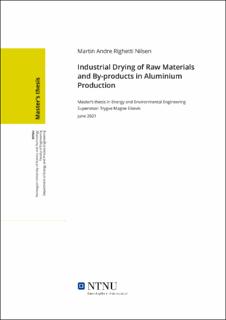| dc.contributor.advisor | Eikevik, Trygve Magne | |
| dc.contributor.author | Nilsen, Martin Andre Righetti | |
| dc.date.accessioned | 2021-10-14T17:19:58Z | |
| dc.date.available | 2021-10-14T17:19:58Z | |
| dc.date.issued | 2021 | |
| dc.identifier | no.ntnu:inspera:80323162:20909153 | |
| dc.identifier.uri | https://hdl.handle.net/11250/2823137 | |
| dc.description.abstract | I denne masteroppgaven utforskes muligheten for å bruke spillvarme fra avgasser i aluminiumsproduksjonsprosessen med det formål å tørke biprodukter som oppstår og råmaterialer som inngår i denne prosessen.
Innledningsvis ble fundamentale prinsipper i tillegg til noen generelle økonomiske betraktninger introdusert. Deretter ble det utført en litteraturstudie der fronten i teknologiutviklingen beskrives, med fokus på hvilke utfordringer som møtes i forbindelse med utnyttelse av spillvarme i aluminiumsindustrien. I tillegg ble ulike teknologier og teknikker innenfor industriell tørking beskrevet. Deretter ble det foretatt en kartlegging og evaluering av hvilke varmekilder og varmestrømmer på fabrikken til Alcoa i Mosjøen som er mulig å utnytte. Videre ble det gjennomført eksperimenter for å fastslå fuktinnhold og tørkekinetikk i aluminiumsoksid, anodemasse og petroleumskoks, med det formål å kunne gjøre innledende beregninger på energi og effektbruk i tørkeprosessen. Resultatene viste at det var betydelig mer varme tilgjengelig enn varmebehovet for tørking.
Senere ble det gjennomført en kostnadsanalyse der kostnader knyttet til kjøp, installasjon og drift av en industriell rotasjonstørker. Denne analysen dannet grunnlaget for en analyse av profitabiliteten til investeringen i en tørker, der tilbakebetalingstiden på prosjektet ble evaluert. Konklusjonen av denne analysen viste en estimert tilbakebetalingstid på fire måneder, i beste tilfelle, og 3 år, i verste tilfelle, avhengig av ulike faktorer. | |
| dc.description.abstract | In this thesis, the case of utilizing excess heat from surplus heat from process off-gases in the aluminium production process for industrial drying of raw materials and by-products is investigated.
Initially, some fundamental principles, as well as some basic economic considerations, were introduced. Furthermore, a literature review of where the research is at currently with regards to the challenges faced when capturing heat from the exhaust gasses in the aluminium industry was conducted. In addition, drying research literature which is related to the range of available drying technologies and techniques was reviewed. A mapping and evaluation of potential heat sources available in the Alcoa Mosjøen plant was carried out. Furthermore, experiments on the moisture content and drying kinetics of aluminium oxide, anode mass and petroleum coke were conducted, so that drying calculations could be made with the aim being to give an estimate of how much energy is available as surplus heat, and to determine the specific heat expenditure of drying the by-products. The results showed that there was a significantly larger amount of available heat than the required amount.
A subsequent analysis of the costs related to the purchase, installation and operation of an industrial rotary dryer was used as a basis for an analysis of the profitability of investing in a dryer, where the payback period of the project was evaluated. The conclusion of the aforementioned analysis yielded a payback period of between four months, as a best-case scenario, and three years, as a worst-case scenario, depending on various factors. | |
| dc.language | eng | |
| dc.publisher | NTNU | |
| dc.title | Industrial Drying of Raw Materials and By-products in Aluminium
Production | |
| dc.type | Master thesis | |
